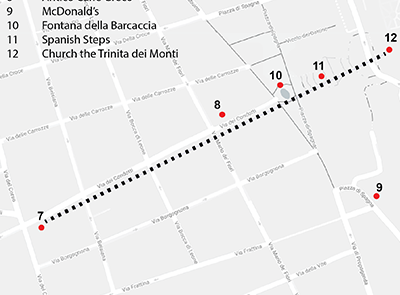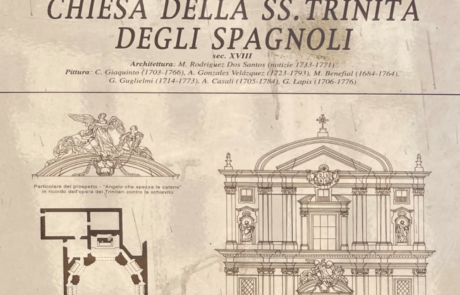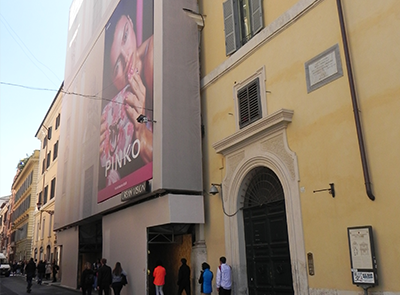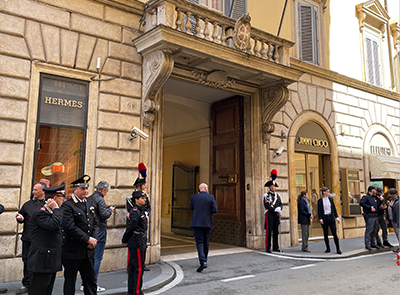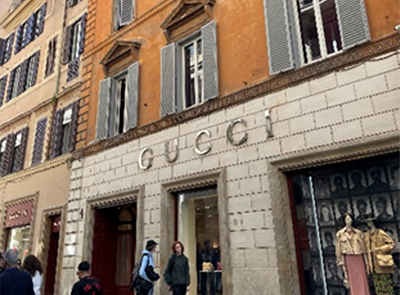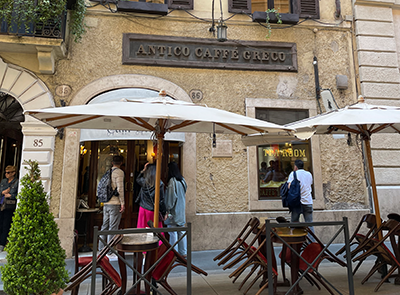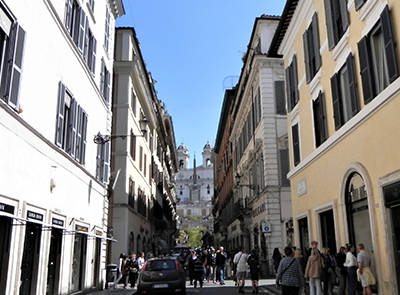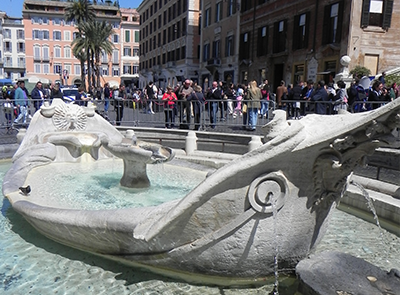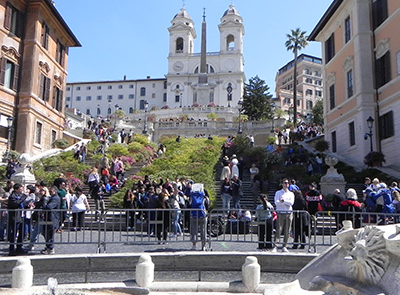
Continuing walking north in the direction of the Piazza del Popolo, one cannot resist turning to the right at Via dei Condotti and look at this busy and fashionable street of Rome.
This famous Via has been part of the history of the city, with interesting historical aspects such as its name; originally it was called TRIDENTE for being the junction point between Via del Corso and Piazza di Spagna. With the beginning of the” Modern Era of Rome” in the 15th -century, the old Via changes its name due to the expansion of the Acqua Vergine aqueduct and was called Via Condotta (the Conduct Street), later changed to Via Condotti.
In the 18th -century the northern part of the city, had an incredible urban development, with the construction of Modern Palaces, nowadays the palaces originally built for the Italian aristocracy are home to some of the Italian high style fashion firms because via dei Condotti is one of the most expensive shopping streets in the world, center of Greatest Luxury Italian Retailers in Rome.
Starting to walk along this via, heading the corner of via del Corso and via dei Condotti, is the church Santissima Trinita’ degli Spagnoli known also as church of the Santissima Trinita a Via Condotti; this beautiful baroque church goes unnoticed by the hundreds of tourists who walk along this via because it was placed between two buildings.
Designed by the Portuguese architect Emanuel Rodriguez de Santos assisted by the Italian architect Giuseppe Sardi in 1741-46, is a great example of the late baroque; with a concave façade designed with great harmony and proportion slight curved walls made up two orders of columns and pilasters separated by a cornice with triangular tympanum at the top and a single entrance with a group of sculpture over the doorway and a central window with a decorative pediment. This church is one of the national churches of Spain in Rome.
Continuing my journey through this busy and fashion via of Rome, where you can see all the boutique of the Luxury Italian retailers set in an old palazzo, making this way a wonderful journey not only for its historical and architectural monuments, but also for a luxury high style shopping…
Notable examples of luxurious palaces can still be seen in this via, such as the Palazzo di Malta, which does not go unnoticed because of its flags hanging f the balcony.
Just a block before finishing the end of this street, is the famous “Antico Caffe’ Greco”, which is the oldest café in Rome (opened in 1760). This classic and elegant building represents a symbol of the city and it is an obligatory stop to enjoy the collection of artworks that decorate the walls of this famous landmark. You can also sit outside and enjoy a delicious “Cappuccino” while observing tourists passing along.
One interesting experience is going from the glamour of the Caffe’ Greco to what is considered the most elegant McDonald’s in the world, located across the piazza Spagna.
However, before walking onto the Spanish Steps or even going to McDonalds, one finds a notable baroque fountain in the middle piazza, it is called Fontana della Barcaccia (fountain of the longboat or the ugly boat) credited to Pietro Bernini, father of the famous sculptor and architect Gian Lorenzo Bernini.
Of course, my detour is not complete without climbing the famous Spanish Steps that lead me to the church of “Trinita dei Monti.” It is worth to say that the name of this place can be confusing because the Spanish embassy was located in the “Piazza Spagna” (at the bottom of the steps); however, the official name is “Scalinata della Trinita dei Monti”.
This famous place was built at the beginning of the 18th – century to connect piazza Spagna and the church (located at the top). An interesting fact is that the project was a design competition which was won by Francesco de Santis in collaboration with Alessandro Specchi, designing symmetrical stairs with three terraces, and planters (garden stairs), decorated with statues. Over the years the steps became one of the most popular attractions in the city because of its privileged location, so people can sit on the steps, relax, and enjoy the view of Via dei Condotti.
Interestingly fact, I started the tour along this Via with the church of the Holy Trinity owned by the Spanish Catholic Church and now I will complete the tour of Via dei Condotti, climbing the 135 steps of the stairs “Scalinata”, to reach the “Church of the Trinita dei Monti”, which is a French State property.
This church, which is the focal terminating point from the Via dei condotti is also one of the few examples of the Renaissance style in Rome, its construction started in 1502 under the design of the architects Annibale Lippi and Gregorio Caronica in Gothic style. Around 1570 the facade was modified (especially the twin towers originally built in Gothic style) and it is assumed that it was completed by the architects Giacomo Della Porta and Carlo Maderno.
In front of the church of Trinita dei Monti stands the Obelisco Sallustiano (constructed in the early years of the Roman Empire near Porta Salaria and moved there in 1789). I highly recommend paying a short visit to it, not only to see the interior decoration and pieces of art of this church, but also from the terrace that precedes the entrance to the church is one of the best places where you have a wonderful view of the city and of course the street.


